Understanding the Impact of California Wildfires on Communities
The Adverse Effects on Residents
California wildfires have become an increasingly prevalent crisis, devastating numerous communities and causing significant emotional and financial turmoil for residents. Many individuals find themselves battling not only the flames but also the aftermath: lost homes, displaced families, and shattered lives.
Personal Narratives of Loss
The destructive nature of these fires has left countless families grappling with profound loss. For instance, survivors often recount their harrowing experiences—evacuating with little notice while leaving cherished belongings behind. Such narratives highlight the urgent need for disaster preparedness and support systems in place to assist those affected.
Economic Repercussions
In addition to personal tragedies, the economic ramifications are profound. According to recent reports from state authorities, damages caused by last year’s wildfires reached an astounding $10 billion. Businesses face enormous setbacks due to property destruction while local economies struggle with decreased tourism revenues as potential visitors steer clear of fire-prone areas.
Vulnerable Populations at Higher Risk
Certain demographics experience greater vulnerability during wildfire events. Low-income households often reside in high-risk zones yet lack adequate resources or insurance coverage to safeguard against such disasters. Additionally, many elderly residents find evacuation particularly challenging due to mobility issues or health concerns.
Mental Health Challenges
The psychological impact cannot be overlooked either—individuals directly affected by wildfires frequently suffer from anxiety, depression, and post-traumatic stress disorder (PTSD). Recent studies suggest that a large percentage of survivors report ongoing mental health struggles long after flames are extinguished.
Community Resilience Efforts
Despite these challenges, many communities demonstrate remarkable resilience in rebuilding efforts post-wildfire. Local organizations emerge to provide assistance ranging from immediate aid supplies to long-term rebuilding guidance for fire-impacted residents.
Success Stories in Recovery
One shining example is a community initiative that formed immediately following a major wildfire event last year; volunteers organized food drives and temporary housing solutions for evacuees while raising funds for reconstruction projects—demonstrating heartfelt solidarity among neighbors determined not only to recover but also strengthen community bonds moving forward.
Conclusion: Moving Towards Awareness and Preparedness
As climate change contributes increasingly intense fire seasons across California so too must our understanding of its victims evolve accordingly—from acknowledging economic implications down through individual stories marked by resilience amidst despair—all presenting critical lessons needed as society prioritizes both preparedness initiatives alongside recovery measures geared towards healing damaged communities effectively now more than ever before.































